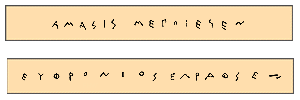

In Classical Athens the craftsman - whether artisan or artist - was a skilled worker who relied on his craft for his income. Craftsmen included sculptors, architects, cobblers, metalworkers (goldsmiths, silversmiths and blacksmiths), potters, vase-painters and painters. There were numerous shipbuilders and vase-painters in Classical Athens. Information concerning craftsmen comes both from both literary texts and from archaeological data.
Literary sources give further information on the socio-economic status of the craftsman in Classical Athens. They show us what his relationship with his clients and with other craftsmen were like, and what he was doing when he was not in his workshop. When Xenophon uses the word 'banausic' to describe craftsmen (Oikonomikos 4,2-3a) he means that the nature of their work gave them no margin of leisure to cultivate their moral and civic talents. Yet ancient writers frequently applauded craftsmen for their creativity and technical brilliance. Literary sources have preserved the names of some craftsmen, for example the names of Athenian sculptors. The craft was passed down from father to son: for instance, there were the father and brother of Antenor and Kritias and Nesiotes, probably younger relatives of theirs - all sculptors. Lykios son of Myron, one of the greatest sculptors of the Classical period, followed in his father's footsteps, and both Kephisodotos (at the end of the fifth century B.C.) and his son Praxiteles after him, worked as sculptors.

Most ancient craftsmen left no traces. Occasionally, however, from as early as the seventh century B.C., a signature appears on a piece of work. In Classical Athens in particular, around the year 470 B.C., potters and vase-painters would add their signatures to their fine-quality pots, a practice which later become much rarer. A potter would sign himself '(so-and-so) created' or 'created me'; a vase-painter '(so-and-so) scribed' (or 'scriphed'). There are more potters' signatures than painters', which has been taken by some scholars to mean that of the two the potter was the more important. Many potters' and painters' names (for example, Kolchas, Skythes or Thrax) imply a foreign origin. The best of these craftsmen were able to combine two or three skills (for example potting, architecture and painting). Pheidias, for example, besides making bronze, gold and ivory statues, also supervised the Acropolis building programme, and his brother Panainos, who started out as a painter, went on to work in bronze and silver.
 |
 |
|
| |
|||
| |||